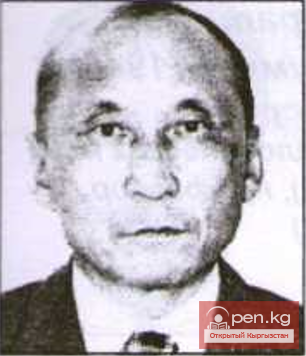
Sadykov Abdykadir (1933), Doctor of Philological Sciences (1972), Professor (1983), Corresponding...

Attykurova Altynai Razbaevna Art historian. Born on November 23, 1973, in the village of Gulcha,...

Literary scholar, prose writer, poet Dz. Tashtemirov was born on October 15, 1913—October 7, 1988,...

Sadikov Tashpolot (1949), Doctor of Philological Sciences (1995) Kyrgyz. Born in the village of...

Critic and literary scholar A. Sadikov was born in the village of Kara-Suu in the At-Bashinsky...

Poet and playwright J. Sadykov was born on October 23, 1932, in the village of Kichi-Kemin, Kemin...

Poet and prose writer T. Miyashev was born in the village of Papai in the Karasuu district of the...

Sadykov Turgunbay (1935), sculptor, public figure, academician of the National Academy of Sciences...

Sadikov Rysbek Esenkulovich (1929 - 1986) Doctor of Agricultural Sciences (1972), Professor...

ISAEV Askar Isaevich...

Species of higher plants removed from the "Red Book" of Kyrgyzstan (1985) Species of...

Poet B. Sarnogoev was born on January 14, 1932, in the village of Budenovka, Talas District, Talas...

Tabaldiev Asanbek (1935-1975), Doctor of Philosophy (1971), Professor, Corresponding Member of the...

Sadikov Turgunbay Sadikovich Sculptor. Hero of the Kyrgyz Republic, People's Artist of the...

Prose writer and critic D. Kazakbaev was born on June 20, 1940, in the village of Dzhan-Talap,...

Omuraliyev Ashymkan (1928), Doctor of Historical Sciences (1975), Professor (1977) Kyrgyz. Born in...

Poet S. Dzhusuev was born in the wintering place Kyzyl-Dzhar in the current Soviet district of the...

Isaev Kusein (1937), Doctor of Philosophy (1983), Professor (1985) Kyrgyz. Born in the village of...

A Kyrgyz delegation headed by the Minister of Education and Science of the Kyrgyz Republic K....

Isayev Akibai (1932-1999), Doctor of Geographical Sciences (1989), Professor (1990), Laureate of...

Critic and literary scholar K. Asanaliev was born on June 10, 1928, in the village of Sokuluk (now...

Insect species listed in the 2004 IUCN RLTS, not included in the Red Book of Kyrgyzstan 1....

Poet N. Zharkynbaev was born in the village of Dzhanay-Aryk in the Jumgal district of the Naryn...

Sadikov Turgunbay – Kyrgyz sculptor and monumental artist, chairman of the cultural foundation of...

Kanat Sadykov himself spoke about this at a press conference. "I predicted that I would...

Poet and playwright J. Bokonbaev was born on May 16, 1910 — July 1, 1944, in the village of...

Osmonov Anvar Osmonovich (1941), Doctor of Veterinary Sciences (2000) Kyrgyz. Born in the village...

By September 1, 23 schools will be completed in Kyrgyzstan, as reported by the Minister of...

Poet and prose writer I. Isakov was born on September 1, 1933, in the village of Kochkorka,...

Prose writer D. Su laymanov was born in the village of Jilaymash in the Sokuluk district of the...

Zhakypov Ybrai (1918), Doctor of Philological Sciences (1967), Professor (1969) Kyrgyz. Born in...

Poet A. Degenbaeva was born on May 12, 1941, in the village of Belovodskoye, Moscow District,...

Estebes Tursunaliev (born 1931) — akyn-improviser, People's Artist of the USSR (1988),...

Sydykov Arstanaaly Arstambekovich Painter. Born on February 2, 1952, in the village of Kerben,...

Critic, literary scholar B. Kerimdzhanova was born on October 30, 1920, in the village of...

Poet and prose writer M. Seitaliev was born in the village of Uch-Emchek in the Talas district of...

Monumentalists of the New Generation in Kyrgyzstan In the 1970s, with the arrival of sculptors and...

ALYMKULOV Urmat Nazarbekovich...

Prose writer K. Bayalynov was born on September 25, 1902—September 3, 1979, in the Kotmaldy area...

Poet and playwright Dzh. Turusbekov was born in the village of Kok-Sai in the current Ton district...

Doolataliyev Seyit (1940), Doctor of Economic Sciences (1993), Professor (1997) Kyrgyz. Born in...

Umetalieva Jamal Temirkulovna Art historian. Doctor of Arts. Honored Worker of Culture of the...

Critic, literary scholar Kadyrbek Matiev was born in the village of Ak-Took in the Suzak district...

Telekmato Baktibek Asanbekovich Theater artist. Born in 1966 in the village of Ak-Tash, Kara-Suu...

Critic, literary scholar, prose writer Sh. Umetaliev was born on February 10, 1925, in the village...

Asanbay Karimov (1898— 1979) — an outstanding folk professional choorchu. A self-taught musician,...